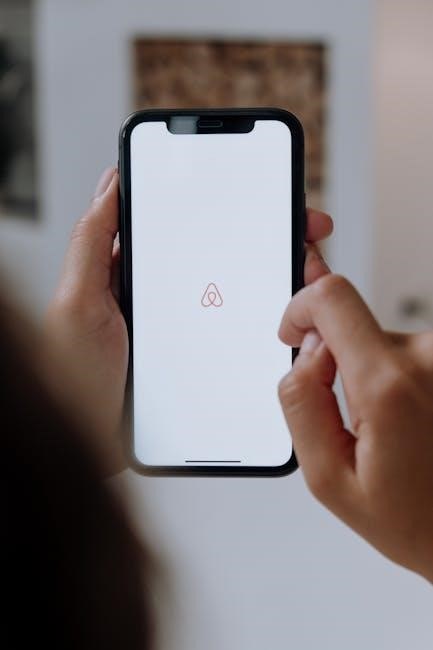The Sensaphone 400 is a programmable environmental monitoring system designed for reliable, remote, and on-site monitoring in homes, businesses, and remote facilities.
1.1 Overview of the Sensaphone 400 Monitoring System
The Sensaphone 400 is a fully programmable environmental monitoring system designed for reliable, remote, and on-site monitoring of various environmental conditions. It offers extensive monitoring capabilities for temperature, humidity, and other critical factors, making it ideal for homes, businesses, farms, greenhouses, and remote facilities. The system provides real-time alerts and notifications, ensuring prompt action can be taken to prevent damage or disruptions. Its versatility and ease of use make it a trusted solution for protecting valuable assets and ensuring operational continuity.
1.2 Key Features and Benefits
The Sensaphone 400 offers a range of advanced features, including programmable monitoring scenarios, remote access capabilities, and customizable alerts; It supports multiple environmental sensors for temperature, humidity, and more. The system provides real-time notifications via SMS, email, or desktop monitoring software. Its user-friendly interface ensures easy setup and configuration. Designed for reliability, the Sensaphone 400 is ideal for protecting critical assets in various environments, from homes to industrial settings. Its versatility and robust monitoring capabilities make it a comprehensive solution for preventing damage and ensuring operational continuity.
1.3 Intended Use Cases
The Sensaphone 400 is ideal for monitoring environmental conditions in residential, agricultural, and industrial settings. It is commonly used in homes, farms, greenhouses, and remote facilities to track temperature, humidity, and other critical factors. The system is also suitable for server rooms, data centers, and commercial properties requiring 24/7 monitoring. Its remote alert capabilities make it a reliable solution for preventing damage from environmental changes, ensuring operational continuity, and protecting valuable assets in various environments.

Safety Precautions and Warnings
Read instructions carefully, avoid heat sources, and keep the unit away from water. Ensure proper power supply and avoid overloading circuits for safe operation.
2.1 General Safety Guidelines
To ensure safe operation, carefully read the manual and follow all instructions. Avoid placing the Sensaphone 400 near heat sources or water. Keep openings unblocked to prevent overheating. Use only the recommended power supply and avoid overloading circuits. Do not disassemble the unit or insert objects through ventilation holes, as this may cause electric shock or fire hazards. Regularly inspect the power cord for damage and avoid resting objects on it. Store the device in a dry, cool environment, and handle it with care to prevent physical damage.
2.2 Electrical Safety Precautions
Ensure the Sensaphone 400 is used with a power supply matching its AC transformer rating. Avoid overloading circuits, as this can cause fire hazards. Do not modify the system or use unauthorized adapters. Keep the unit away from water to prevent electric shock. Properly ground the system to avoid electrical faults. Never attempt repairs yourself; contact authorized personnel. Regularly inspect cords for damage and avoid pinching or crushing them. Follow all FCC Part 68 guidelines and ensure the REN does not exceed local limits. Always use approved adapters and maintain proper electrical connections.
2.3 Handling and Storage Recommendations
Handle the Sensaphone 400 with care to avoid damage. Store it in a cool, dry place, away from direct sunlight and moisture. Avoid stacking heavy objects on the unit. During transportation, use the original packaging to prevent damage. Keep the system away from extreme temperatures and humidity. Ensure all components are securely fastened before moving. Do not expose the unit to corrosive substances or vibrations. Regularly inspect the system for physical damage and clean it as needed. Proper storage ensures optimal performance and longevity of the device.

Installation and Setup
Follow the manual for proper installation, ensuring the power source matches the unit’s rating. Place the Sensaphone 400 away from water and heat sources for optimal performance.
3.1 Pre-Installation Requirements
Before installing the Sensaphone 400, ensure a stable power source matches the unit’s rating. Avoid placing it near water, heat sources, or areas prone to physical damage. Verify all ventilation openings are unobstructed to prevent overheating. Ensure the installation location is dry, cool, and away from direct sunlight. Check for proper grounding to avoid electrical hazards. Review the manual thoroughly and prepare all necessary tools and accessories. Ensure compliance with local electrical and safety standards before proceeding with the installation process.
3.2 Step-by-Step Installation Guide
Begin by unpacking and inventorying all components. Mount the Sensaphone 400 in a secure, dry location using the provided hardware. Connect environmental sensors to designated ports, ensuring proper alignment. Plug in the power cord and verify the unit powers on. Connect the telephone line to enable remote notifications. Follow the on-screen prompts to complete initial setup. Test all sensors and alarms to ensure functionality. Refer to the manual for detailed instructions and diagrams to guide the process accurately.
3.3 Initial Configuration and Settings
After installation, power on the Sensaphone 400 and follow the on-screen prompts to set the date, time, and timezone. Configure the password for secure access. Set environmental thresholds for temperature, humidity, and other monitored conditions. Define contact telephone numbers for alarm notifications. Enable SMS or email alerts if using remote monitoring. Review and customize all settings to match your specific requirements. Save the configuration and test the system to ensure proper functionality and alert responses. Refer to the manual for detailed instructions on advanced settings.

Configuring Monitoring Parameters
Configure sensors, set alarm thresholds, and customize alerts for temperature, humidity, and other environmental factors to ensure precise monitoring and timely notifications for your specific needs.
4.1 Setting Up Environmental Sensors
Setting up environmental sensors on the Sensaphone 400 involves connecting and configuring devices to monitor temperature, humidity, and other critical conditions. Ensure sensors are placed in optimal locations for accurate readings. Follow the manual’s instructions to connect sensors to the system, ensuring proper wire connections and assignments. Configure each sensor’s settings, such as thresholds and alert levels, to meet your monitoring requirements. Test each sensor to verify correct operation and data transmission. Proper setup ensures reliable monitoring and timely alerts for environmental changes. Regularly inspect and maintain sensors for optimal performance.
4.2 Defining Alarm Conditions and Notifications
Define alarm conditions by setting specific thresholds for temperature, humidity, and other monitored parameters. Assign notifications to trigger when these thresholds are exceeded or when a sensor detects an abnormal condition. Configure alerts to send notifications via SMS, email, or phone calls to designated contacts. Customize the notification messages to include details such as the type of alarm and the affected sensor. Ensure all settings are saved to activate the alerts. Regularly test the system to confirm notifications are delivered correctly and reliably. This ensures prompt responses to critical environmental changes.
4.3 Customizing Monitoring Alerts
Customize monitoring alerts to suit specific needs by personalizing notification preferences. Users can select notification types, such as SMS, email, or voice calls, and define the order of contact attempts. Create custom messages for each alert, including details like sensor name, current reading, and time of trigger. Enable escalation protocols to notify additional contacts if the primary recipient doesn’t acknowledge the alert. Set quiet periods to suppress notifications during specific times. Customize alert acknowledgment requirements to ensure responses are tracked. Tailor the system to prioritize critical alerts and reduce false notifications.

Remote Monitoring and Alerts
The Sensaphone 400 allows remote monitoring through SMS, email, or desktop systems, ensuring timely alerts for environmental changes and system issues from any location.
5.1 Enabling Remote Access
To enable remote access on the Sensaphone 400, users must configure the system to connect to a network. This involves setting up an IP address, subnet mask, and gateway. Ensure the device is connected to a stable internet connection. Use the Sensaphone desktop monitoring software to establish remote monitoring capabilities. Verify network settings and test connectivity to confirm remote access functionality. This setup allows users to receive alerts and monitor conditions from any location via SMS or email notifications.
5.2 Configuring SMS and Email Notifications
Configure SMS and email notifications by accessing the notification menu in the Sensaphone 400 system. Enter the recipient’s contact information, including phone numbers and email addresses. Select the specific alarm conditions that trigger notifications. Choose notification formats, such as detailed alerts or summaries. Enable SMS notifications by setting up the appropriate gateway settings. Test the configuration to ensure alerts are delivered correctly. This feature ensures timely alerts are sent to designated users, providing real-time monitoring and peace of mind.
5.3 Using the Sensaphone 400 Desktop Monitoring System
Launch the desktop monitoring system by installing and opening the Sensaphone 400 software. The dashboard provides an intuitive interface to view real-time data from connected sensors. Monitor temperature, humidity, and other environmental parameters at a glance. Use status indicators to quickly identify normal or alarm conditions. Navigate through menus to access historical data, configure alerts, or adjust settings. Customize the layout to prioritize critical sensors or alarms. The desktop system allows for seamless control and monitoring, ensuring prompt responses to environmental changes or system alerts.

Advanced Features and Customization
The Sensaphone 400 offers advanced customization options, enabling users to program custom monitoring scenarios, integrate with external systems, and expand the system with additional sensors.
6.1 Programming Custom Monitoring Scenarios
The Sensaphone 400 allows users to create custom monitoring scenarios tailored to specific needs. By programming unique conditions, users can define triggers for temperature, humidity, or other environmental factors. The system enables customizable alerts and notifications, ensuring timely responses to critical changes. Users can also integrate external systems for enhanced functionality. The intuitive interface simplifies the setup process, making it easier to program and manage complex monitoring tasks. This flexibility ensures the system adapts to various environments, providing reliable protection for assets and operations.
6.2 Integrating with Other Systems
The Sensaphone 400 can seamlessly integrate with other systems to enhance monitoring capabilities. Users can connect it to external devices, such as alarms or automation systems, for centralized control. The system supports third-party software and communication protocols, enabling data sharing and advanced monitoring solutions. Integration options allow for customized workflows and enhanced functionality, ensuring the Sensaphone 400 adapts to diverse operational needs. This flexibility makes it an ideal choice for environments requiring comprehensive monitoring and system interoperability.
6.3 Expanding the System with Additional Sensors
The Sensaphone 400 allows for system expansion by adding environmental sensors to monitor temperature, humidity, water, and more. Users can connect up to eight external sensors, ensuring comprehensive coverage of critical conditions. Each sensor can be configured to trigger specific alarms, enhancing the system’s adaptability. The process involves connecting sensors to designated ports and configuring settings through the system interface. This flexibility enables users to tailor the monitoring setup to their specific needs, ensuring robust protection for sensitive environments. Additional sensors can be added as required, making the system scalable for growing demands.

Troubleshooting Common Issues
Identify and resolve system errors by checking power connections, sensor functionality, and communication links. Review alarm settings and consult the user manual for detailed solutions.
7.1 Identifying and Resolving System Errors
To identify system errors, check the Sensaphone 400’s status indicators and error logs. Common issues include power outages, sensor malfunctions, or communication failures. Ensure all connections are secure and verify sensor calibration. If the system fails to respond, perform a power cycle by unplugging and reconnecting the device. Consult the user manual for specific error codes and recommended solutions. For persistent issues, contact Sensaphone support for advanced troubleshooting or repair options.
7.2 Addressing Communication Failures
Communication failures with the Sensaphone 400 can occur due to lost connections or incorrect settings. First, verify all physical connections, such as phone lines or Ethernet cables, are secure. Ensure the system has power and is properly configured. Check for delays in notifications, which may indicate temporary network issues. Restart the system to reset connections. If issues persist, review the communication settings in the configuration menu and confirm that all contact information is accurate. Contact customer support if problems remain unresolved.
7.3 Solving Sensor Connectivity Problems
Sensor connectivity issues can disrupt monitoring. First, ensure all sensors are properly connected to the Sensaphone 400 and powered on; Check cables for damage or loose connections. Restart the system to reset sensor communication. If a sensor remains unresponsive, verify its placement and signal strength. Ensure no physical obstructions block the signal path. Review the sensor configuration in the system settings to confirm correct assignment. Replace faulty sensors if necessary. Consult the user manual or contact support for further assistance if issues persist.

Maintenance and Upkeep
Regularly inspect sensors, clean the system, and ensure secure connections. Check battery levels and replace as needed. Update firmware periodically to maintain optimal performance and security.
8.1 Regular Maintenance Tasks
Perform routine inspections of sensors and connections to ensure proper functionality. Clean the system to prevent dust buildup and maintain optimal performance. Check battery levels in wireless sensors and replace them as needed to avoid interruptions. Verify that all cables are securely connected and free from damage. Review alarm logs to ensure notifications are functioning correctly. Regularly update firmware and software to maintain security and performance. Inspect the physical condition of the unit and address any wear or tear promptly to prevent operational issues.
8.2 Updating Firmware and Software
Regularly update the Sensaphone 400’s firmware and software to ensure optimal performance and security. Check for updates via the system interface or Sensaphone’s official website. Backup settings before proceeding to prevent data loss. Follow on-screen instructions for a smooth update process. Verify the update’s success by restarting the system and checking the version number. Updates may enhance features, fix bugs, or improve compatibility with sensors and communication systems. Always use authorized sources to download updates to avoid unauthorized modifications or security risks.
8.3 Cleaning and Inspecting the System
Regularly clean and inspect the Sensaphone 400 to maintain its performance. Use a soft, dry cloth to wipe the exterior and avoid liquids, which may damage the unit. Inspect vents for dust buildup and clean with a soft brush to ensure proper airflow. Check all cables and connections for damage or wear. Ensure the system is powered off before cleaning. Follow safety guidelines to prevent electrical hazards. Schedule inspections every 6 months to identify and address potential issues early, ensuring reliable operation and extending the system’s lifespan.

Compliance and Regulatory Information
The Sensaphone 400 complies with FCC Part 68 and Canadian Department of Communications standards, ensuring safe and lawful operation across various regions and regulatory requirements.
9.1 FCC Compliance and Part 68 Rules
The Sensaphone 400 adheres to FCC Part 68 regulations, ensuring compatibility with telephone networks. It features an FCC Registration Number and Ringer Equivalence Number (REN) on its label. Users must provide this information to their local telephone company upon request. The REN helps determine the maximum number of devices that can be connected without affecting call functionality. Compliance with these rules ensures uninterrupted service and prevents potential disconnection due to network interference. Proper installation and usage are essential to maintain compliance.
9.2 Canadian Department of Communications Standards
The Sensaphone 400 is certified by the Canadian Department of Communications, meeting specific safety and operational requirements. Users must ensure compliance with local telecom regulations before installation. The Load Number (LN) of 0.3 prevents telephone loop overloading. Repairs should only be performed by authorized facilities to maintain certification and avoid service disruption. This certification ensures the device operates safely within Canadian telecommunications networks, providing reliable monitoring without compromising network integrity.
9.3 CE and Other International Certifications
The Sensaphone 400 complies with CE marking, indicating conformity to EU health, safety, and environmental protection standards. It meets essential requirements of EU directives, ensuring safe operation and electromagnetic compatibility. The device also adheres to international standards like RoHS and WEEE, promoting eco-friendly design and waste management. These certifications enable the Sensaphone 400 to be used globally, ensuring compliance with regional regulations and providing users with assurance of reliability and safety in international markets;

Warranty and Support
The Sensaphone 400 is backed by a one-year warranty covering defects in materials and craftsmanship. Warranty terminates if damaged by external factors, modified, or improperly installed.
10.1 Warranty Terms and Conditions
The Sensaphone 400 is covered by a one-year limited warranty from the date of purchase, protecting against defects in materials and craftsmanship. This warranty does not apply to damage caused by external factors such as fire, water, or lightning, or to units that have been modified or improperly installed. To maintain warranty validity, users must retain the original purchase receipt as proof of ownership. Repairs under warranty are performed at Sensaphone’s discretion, either by repairing or replacing the defective unit. For full details, refer to the warranty section in the user manual.
10.2 Contacting Customer Support
For assistance with your Sensaphone 400, contact customer support directly. Support is available to address troubleshooting, repairs, and general inquiries. You can reach them via phone at the number provided in the manual or through email for non-urgent matters. Additionally, visit the official Sensaphone website for support resources, including FAQs and contact forms. The support team is dedicated to resolving issues promptly and ensuring optimal system performance. Always have your product serial number ready for faster service.
10.3 Service and Repair Options
For service and repairs, contact authorized Sensaphone service centers. Returns require pre-authorization and an RMA number. Repairs under warranty cover parts and labor for one year. Damages from misuse, water, or improper installation are excluded. Ship units securely, ensuring all accessories are included. Unauthorized repairs void the warranty. Visit the official website for repair forms and instructions. Always use Sensaphone-approved replacement parts for optimal performance and safety.